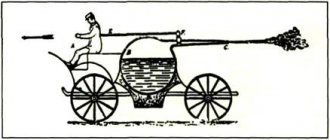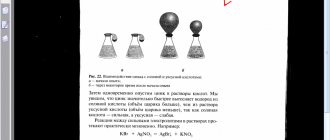Physics lesson summary “Inertia. Interaction of bodies"; 7th grade
Lesson topic. Inertia. Interaction of bodies. Lesson objectives:
- introduce students to the concept of “interaction of bodies”, reveal the essence of inertial motion, develop the ability to distinguish between interactions and characterize them;
- form the concept that a change in the speed of a body or its deformation can serve as a measure of the action of other bodies on this body;
- develop students’ logical thinking, ability to analyze and conduct research, and form a scientific worldview.
Equipment : inclined plane, cart, sand, ruler, plasticine, rubber ball, two steel and plasticine balls.
Lesson stage Time Methods and techniques 1 Updating basic knowledge 5 - 10 min. questions for class 2 Studying new material 20 - 25 min. Conversation, group work, staging and discussion of experience, writing notes 3 Consolidating new material 10 - 15 min. Conversation 4 Homework 1 - 2 min. Notes on the board and in diaries PROGRESS OF THE LESSON 1. Updating basic knowledge Question to the class: - What is called mechanical movement? - What types of movement do you know? — Which of them are most often found in nature and in technology? — What characteristics of movement do you know? 2. Studying new material Conversation Question to the class: - As a result of what do bodies change their speed? — There is a steel ball on the table. What is its speed relative to the table? — How to change the speed of the ball? (act on it with another body) - What can be said about the speed of the ball after the action of another body on it? (the speed decreases, that is, it changes) - What causes the speed of the ball to change? Conclusion: The action of one body on another leads to a change in speed. Let's try to check this: ((The class is divided into three groups. Each group receives equipment, a plan for conducting an experiment and questions for analyzing the experience.) Teacher's activities Students' activities Introduce students to the task and the conditions for its implementation, regulate the time of work Familiarization with the task, equipment Corrective role Execution of work Discussion of experiments and results of the work of groups Speeches by representatives of groups with a report of the work. Writing down conclusions in notes. Card for group No. 1 Roll a cart from an inclined plane. Pour sand at the base of the plane, with a slide. Repeat the experiment, smoothing the sand over the surface, removing it .Task: compare the braking distance of the trolley in all three cases, draw a conclusion. Card for group No. 2 Squeeze a piece of plasticine, a rubber ball, a spring with your hands and answer the question: - does one body act on the other in this case? - Does it change when Is this the speed of the body? - What happens to the body? (deformed) - Draw a conclusion. Card for group No. 3 Push two balls (first steel, then soft - plasticine). Observe the change in speed of these bodies. Assignment: draw a conclusion from your observations, give your examples of the existence of interaction between bodies in nature. CONCLUSIONS: - The action of one body on another leads to a change in speed. — The action of one body on another leads not only to a change in the speed of the body, but also to its deformation. - In nature, there is only interaction between bodies. The result of which is a change in the speed of bodies or their deformation. Question to the class: - What will happen to bodies if other bodies do not act on them? (the speed of the body will not change). In physics, this phenomenon is called inertia. Notebook entry: Inertia is the phenomenon of maintaining the speed of a body in the absence of the action of other bodies on it. Having left the barrel of the gun, the bullet would continue to move. Maintaining its speed if it were not affected by air. The car would also maintain its speed after turning off. If we compare the braking distance of a car on dry asphalt and on an icy road, we will see that the interactions cancel each other out. In this case, no change in speed and no deformation occur. Although interaction occurs. Experiments prove that the action of one body on another is never one-sided. In nature there is only interaction. Accordingly, after the interaction, the velocities of both bodies change, or their deformation occurs. 3. Consolidation of new material Question to the class: - Why does a cyclist, approaching an incline in the road, increase his speed? - The book is on the table. Compare the force of a book on a table and a table on a book. —Can two physical bodies interact if they do not collide directly with each other? Give examples. — Why is it difficult to hold a hose from which water is pouring under pressure? — The bus passengers felt that they were being drawn towards the left wall of the cabin. How was the bus moving at that moment? — 4. Homework §18, 19 exercises. 5 No. 1-2 Creative task: What would happen to the bodies if all interactions suddenly disappeared? Literature used: 1. Physics. 7th grade _Peryshkin A.V_2013 -224s 2. Control. and self slave. in physics 7th grade. to uch Peryshkina_2013 -112s 3. Physics. 7th grade Problems and solutions. Add. village for the textbook Peryshkina_Filonovich N.V_2004 -112s Full text of the material Synopsis of the physics lesson “Inertia.
Interaction of bodies"; For grade 7, see the downloadable file . The page contains a fragment.
| Author: Trusov Alexander Anatolyevich → trusow 02/17/2015 1 7880 718 | Comment |
Thank you for your mark. If you want your name to be known to the author, log in to the site as a user and click Thank you again. Your name will appear on this page.
Login | Registration
Have an opinion? Leave a comment






